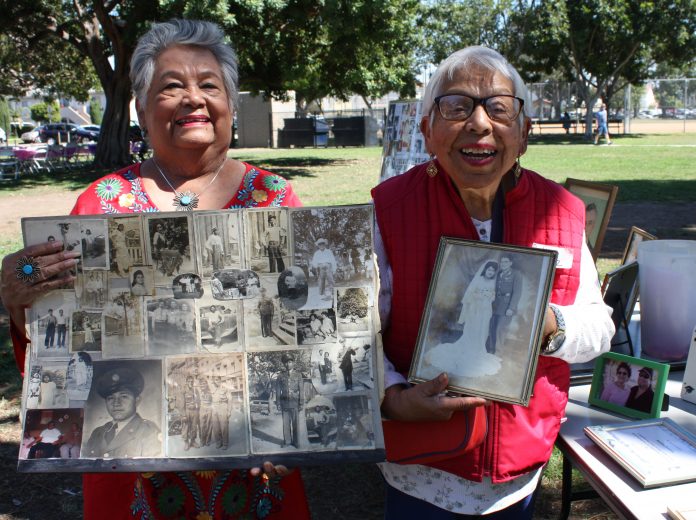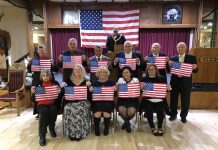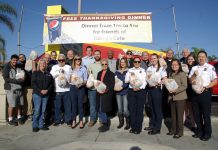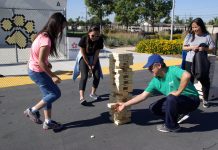BY COLLEEN JANSSEN: History and heritage hold a strong place in the hearts and minds of the people who dwell on Olive Street in Westminster. So much so, that they hold an annual reunion event the last Saturday in September each year for their current and past residents.
The 13th annual celebration, held at Sigler Park, brought almost 300 people to eat, dance, talk, share stories and display family photos.
BY COLLEEN JANSSEN: History and heritage hold a strong place in the hearts and minds of the people who dwell on Olive Street in Westminster. So much so, that they hold an annual reunion event the last Saturday in September each year for their current and past residents.
The 13th annual celebration, held at Sigler Park, brought almost 300 people to eat, dance, talk, share stories and display family photos.
“My maternal grandfather, Juan Mendoza, was a laborer, and he helped build Blessed Sacrament school and church. He was named on a plaque the church made in 1948 to recognize the people who participated in the construction,” said Ricardo Valverde, one of the reunion event organizers. “Our family went to the school there. Father gave me the plaque; it’s faded, so I plan to have it restored.”
“We have people here today who have lived their entire life on Olive Street. One of them, Pauline Ramirez, brought family photos with her today,” added Valverde. “Her sister, Julia Martinez, is here and is going to receive a surprise award.”
“My parents came from Mexico and my father worked on the railroad in Colorado. We came to Olive Street and I was born in our home at Olive and Main,” said Ramirez, age 89. “All of us kids were born at home.”
“When I was 15 or 16, the man who become my husband came home on furlough to my father and asked if he could marry me. My father asked if I wanted to get married and I was bashful, but I said yes. We were married in April 1944,” continued Ramirez. “We had four girls. On the day he was landing in the Philippines, I was in labor with our first daughter on Sept. 27, 1945. When she was three or four month’s old, he came home.”
Her sister, Julia Martinez, age 91, arrived to the reunion with her family, unsuspecting that an award was being presented to her later that afternoon. Many of her family members have moved away, but Martinez still lives in the neighborhood. One of nine children in her family, only she and her sister, Pauline, are left.
“Julia taught Mexican Folklorico dance for many years. She founded Las Tapatias dance group more than 40 years ago. She is a member of the Olive Street Reunion Committee and on the board for the historical society and was an instructional aide at Willmore Elementary,” said Valverde. “We have a plaque here today to recognize her.”
Part of her plaque reads, “The Olive Street Reunion Committee, past dance students and friends in the City of Westminster would like to express their appreciation and thanks for all your accomplishments in making the city a better place to live.”
Another old-timer at the event was Andy Vasquez, age 91, who moved to Olive Street in 1947. When asked what he likes to do, he put down his lunch and replied, “No work; only eating.” Vasquez comes to the reunion every year and looks forward to seeing old friends who have moved away.
A highlight of the event was the table that held photographs. Many of the photos were from more than 50 years ago, showing individual residents and family groups. One photo in particular showed students and their teacher in front of a local school. Some of the students were so poor, they did not have shoes to wear to school. The old photo is torn and aged, and the family is considering having this piece of history restored.
Happiness was in the air as people sat and talked, wandered the tables checking out the raffle prizes, searched the photo collages for loved ones, and stopped by to see the display of military pictures of their veterans and those killed in action. A highlight of the day was the breaking of a piñata.
“There are so many stories. The priest had to say mass in a barn before the church was built,” continued Valverde. “Then the Japanese were sent to the internment camps. The Arellano Farms took over the Japanese land and raised tomatoes, chilis, alfalfa, corn and more. When the Japanese came back, Arellano gave back the farms to their owners. The families were so grateful, they counted everything at the farms and returned anything to Arellano that was not there when they left, then gave him some land to thank him.”
“That’s how things were back then. We took care of each other.”












